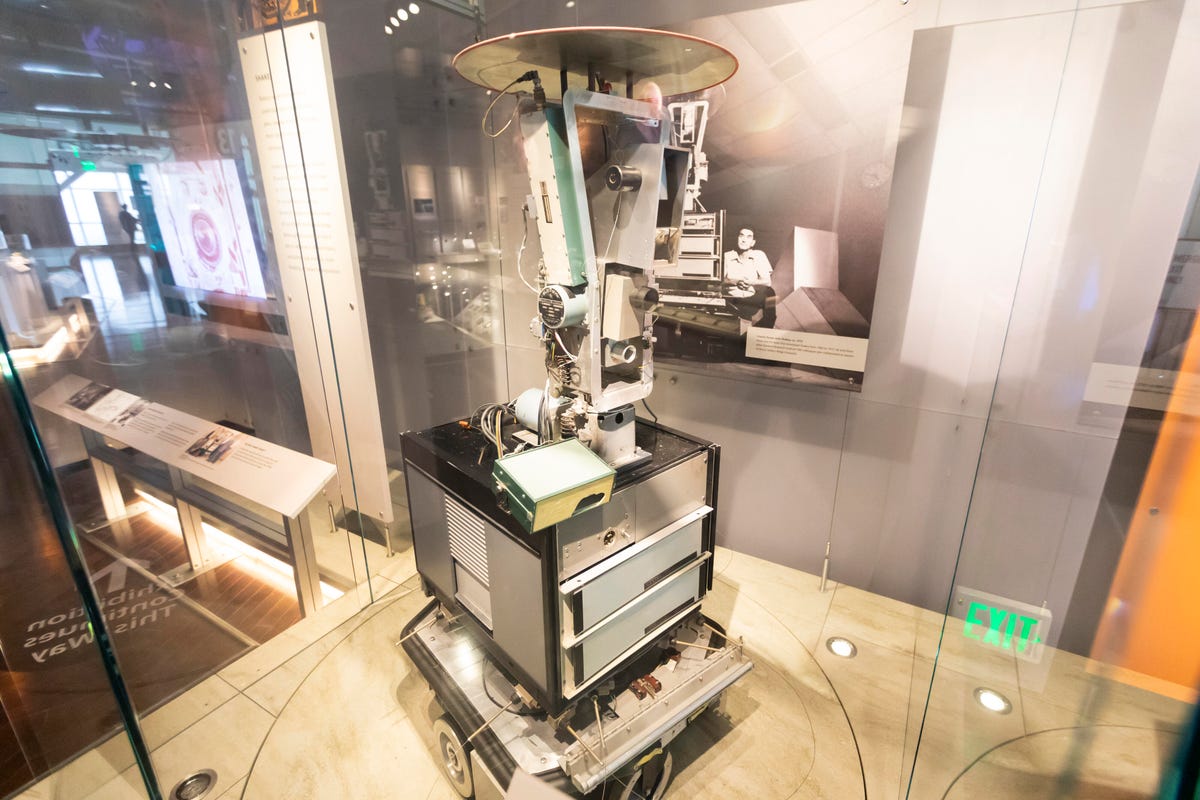 Why You Can Trust CNET
Why You Can Trust CNET Rise of the robots, from sci-fi to our homes
A collection of the history of humanoids

Shakey, Stanford Research Institute, 1969
From Karel Capek's play RUR in 1920 to Isaac Asimov's book I, Robot in 1950 (and the 2004 Will Smith movie inspired by it) and beyond, robots have deep roots in science fiction. But in the latter part of the 20th century, they started to become a science fact, moving out of labs and into industry and households. This is a look at the evolution across recent decades.
Stanford Research Institute's Shakey, which featured camera and touch sensors, was advanced in computer vision and language processing for its era.
Wabot-1, 1973
Wabot-1 was the world's first full-scale anthropomorphic robot, integrating a limb control system, a vision system and a communications platform.
Sensors allowed Wabot-1 to measure distances and directions to objects, and the robot could walk and even grip and move objects with hands that used tactile sensors.
Hubot, Hubotics, 1981
The butler-esque Hubot was advertised as the first home robot that's a personal companion, educator, entertainer and sentry. A voice synthesizer was able to speak about 1,200 words in English.
Andy, 1982
Atari founder Nolan Bushnell founded a company, Axlon, in 1982 to build playful toy robots. Only 2,300 of this robot, Andy, were made. It connected to Commodore 64 or Atari computers and could be controlled with a joystick.
Hero Jr., Heathkit, 1984
Home robot kits from Heathkit were guided by sonar and were able to play games and sing songs, with the ads proclaiming it "seeks to remain near human companions" by listening for voices.
RB5X General Robotics, 1985
RB5X was an educational robot programmed in the TinyBASIC language. Sonar and "bumps switches" helped it move around. A prototype attachment that was supposed to vacuum floors didn't really work very well.
Officer Mac, 21st Century Robotics, 1985
Officer Mac was a remote-controlled law enforcement robot that accompanied police officers, visiting schools and showing videos about public safety.
Omnibot 2000, Tomy Company, 1985
The programmable Japanese Omnibot 2000 could move, talk and carry objects. A cassette player in its chest played audio.
Sentry, Denning Robotics, 1995
This Denning robot security guard could patrol 14 hours, moving at 3 miles per hour, monitoring a 150-foot radius and radioing an alert to a human.
Furby, Tiger Electronics, 1998
The Furby robot was the hot holiday toy in 1998, with resale prices of up to $300.
Out of the box, a Furby spoke only "Furbish" and was able to communicate with other Furbies using infrared, but was able to learn English commands.
Hasbro's Furby, a weird, warbling piece of toy nostalgia that just won't die, is back. Now, though, Furby wants to stay connected via Bluetooth. It might know what time it is, or what the World Series scores are. Furby. Will. Know.
iRobot's Swarm, 1999
This is one element of iRobot's 1999 Swarm robot system. It was based on the behavior of insects and was the company's first experiment with decentralized networked robotic intelligence. The project was funded by DARPA and didn't require a human to independently control each robot in the swarm. Instead, the user could issue a command to one of the robots, and that command would then be shared among the entire swarm.
FIRST robot, 2009
Robotics competitions have become a staple of the educational arena, in part through the efforts of FIRST, an organization founded by inventor Dean Kamen, the man behind the Segway and the DEKA prosthetic arm. The robot pictured here, which includes Lego Mindstorms components, was typical of a high school project.
CB2, 2009
A 73-pound (33kg) "Child-robot with Biomimetic Body," or CB2 (CB squared), equipped with 51 air actuators, five motors and 197 tactile sensors under soft silicone skin, wriggles on a bed at a laboratory in Osaka University in Japan.
PR2 units, 2010
At Willow Garage's launch party in 2010, the company's PR2 units emerge in unison. Institutions that received PR2 robots for research included the Georgia Institute of Technology, the Bosch Research and Technology Center, Stanford University, the University of California at Berkeley, the University of Southern California, the University of Tokyo's JSK Robotics Laboratory and MIT's Computer Science and Artificial Intelligence Laboratory.
Tesla, 2012
Robots in automotive factories typically perform one task (or maybe two). Robots in Tesla's body shop can perform up to five different tasks, increasing efficiency and flexibility.
Honda's Asimo, 2011
Asimo, Honda's humanoid robot, appears during the FIRST Championships at the America's Center on April 28, 2011, in St. Louis.
DARPA's Atlas, 2013
In 2013, DARPA unveiled one of the more frightening and futuristic robots we've ever seen. But the 6-foot humanoid robot, which was developed by Boston Dynamics, wasn't designed to kill -- it's here to help us.
Atlas, with 28 hydraulically actuated joints, was one of the most advanced humanoid robots ever built. It was essentially a physical shell, a starting point for the software brains and nerves to be supplied by the teams in DARPA's Virtual Robotics Challenge.
Swift Playground robotics programming, 2017
Apple's Swift Playgrounds was designed to help kids learn to code by making robots and drones dance.
iRobots inside Fukushima, 2018
After the 2011 Fukushima nuclear disaster, robots offered a sliver of hope for investigating the damaged structures. But even years later, robots were just starting to get close enough to see how bad it really was.
Apple's Daisy recycling robot, 2019
At the center of a new Material Recovery Lab that Apple built in Texas is a recycling robot called Daisy. The lab was designed to share Daisy's technology and help advance electronics recycling.
Samsung's Bot Care, 2019
At CES 2019, Samsung introduced four new robotics initiatives, including Bot Care, a personal health care assistant designed to handle an array of health monitoring tasks.

